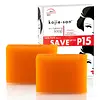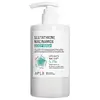What's inside
What's inside
 Key Ingredients
Key Ingredients

 Benefits
Benefits

 Concerns
Concerns

 Ingredients Side-by-side
Ingredients Side-by-side

Cocos Nucifera Oil
MaskingWater
Skin ConditioningSodium Hydroxide
BufferingParfum
MaskingKojic Acid
AntioxidantGlycerin
HumectantXanthan Gum
EmulsifyingCaprylyl Glycol
EmollientGlucose
HumectantChondrus Crispus
MaskingPhenoxyethanol
PreservativeEthylhexylglycerin
Skin ConditioningCocamide DEA
EmulsifyingParaffinum Liquidum
EmollientMelaleuca Alternifolia Leaf Oil
AntioxidantCI 15985
Cosmetic ColorantCI 19140
Cosmetic ColorantBHT
AntioxidantWater
Skin ConditioningSodium Laureth Sulfate
CleansingCentella Asiatica Extract 5.1%
CleansingGlycerin
HumectantPropylene Glycol
HumectantCocamide Mea
EmulsifyingLauramide DEA
Cocamidopropyl Betaine
CleansingGlutathione
Niacinamide
SmoothingCitric Acid
BufferingSodium Hyaluronate
HumectantCaprylic/Capric Triglyceride
MaskingHydrogenated Lecithin
EmulsifyingGlyceryl Stearate
EmollientCholesterol
EmollientNelumbo Nucifera Extract
Skin ConditioningArtemisia Annua Extract
MaskingOryza Sativa Extract
AbsorbentSaccharomyces Ferment
Skin ConditioningSolanum Melongena Fruit Extract
Skin ConditioningMelaleuca Alternifolia Leaf Extract
Perfuming1,2-Hexanediol
Skin ConditioningHydrolyzed Collagen
EmollientBeta-Glucan
Skin ConditioningDipropylene Glycol
HumectantHippophae Rhamnoides Fruit Extract
Skin ConditioningButylene Glycol
HumectantStyrene/Acrylates Copolymer
Xanthan Gum
EmulsifyingMadecassic Acid
Skin ConditioningAsiaticoside
AntioxidantAsiatic Acid
Skin ConditioningSqualane
EmollientPolyquaternium-10
Disodium EDTA
Sodium Benzoate
MaskingChlorphenesin
AntimicrobialSodium Chloride
MaskingWater, Sodium Laureth Sulfate, Centella Asiatica Extract 5.1%, Glycerin, Propylene Glycol, Cocamide Mea, Lauramide DEA, Cocamidopropyl Betaine, Glutathione, Niacinamide, Citric Acid, Sodium Hyaluronate, Caprylic/Capric Triglyceride, Hydrogenated Lecithin, Glyceryl Stearate, Cholesterol, Nelumbo Nucifera Extract, Artemisia Annua Extract, Oryza Sativa Extract, Saccharomyces Ferment, Solanum Melongena Fruit Extract, Melaleuca Alternifolia Leaf Extract, 1,2-Hexanediol, Hydrolyzed Collagen, Beta-Glucan, Dipropylene Glycol, Hippophae Rhamnoides Fruit Extract, Butylene Glycol, Styrene/Acrylates Copolymer, Xanthan Gum, Madecassic Acid, Asiaticoside, Asiatic Acid, Squalane, Polyquaternium-10, Disodium EDTA, Sodium Benzoate, Chlorphenesin, Sodium Chloride
 Reviews
Reviews

Ingredients Explained
These ingredients are found in both products.
Ingredients higher up in an ingredient list are typically present in a larger amount.
Glycerin is already naturally found in your skin. It helps moisturize and protect your skin.
A study from 2016 found glycerin to be more effective as a humectant than AHAs and hyaluronic acid.
As a humectant, it helps the skin stay hydrated by pulling moisture to your skin. The low molecular weight of glycerin allows it to pull moisture into the deeper layers of your skin.
Hydrated skin improves your skin barrier; Your skin barrier helps protect against irritants and bacteria.
Glycerin has also been found to have antimicrobial and antiviral properties. Due to these properties, glycerin is often used in wound and burn treatments.
In cosmetics, glycerin is usually derived from plants such as soybean or palm. However, it can also be sourced from animals, such as tallow or animal fat.
This ingredient is organic, colorless, odorless, and non-toxic.
Glycerin is the name for this ingredient in American English. British English uses Glycerol/Glycerine.
Learn more about GlycerinWater. It's the most common cosmetic ingredient of all. You'll usually see it at the top of ingredient lists, meaning that it makes up the largest part of the product.
So why is it so popular? Water most often acts as a solvent - this means that it helps dissolve other ingredients into the formulation.
You'll also recognize water as that liquid we all need to stay alive. If you see this, drink a glass of water. Stay hydrated!
Learn more about WaterXanthan gum is used as a stabilizer and thickener within cosmetic products. It helps give products a sticky, thick feeling - preventing them from being too runny.
On the technical side of things, xanthan gum is a polysaccharide - a combination consisting of multiple sugar molecules bonded together.
Xanthan gum is a pretty common and great ingredient. It is a natural, non-toxic, non-irritating ingredient that is also commonly used in food products.
Learn more about Xanthan Gum